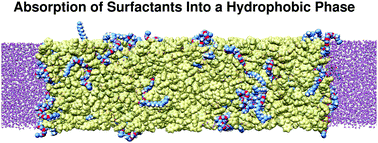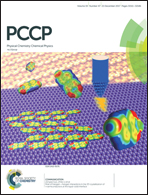Shedding light on the different behavior of ionic and nonionic surfactants in emulsion polymerization: from atomistic simulations to experimental observations†
Abstract
Although surfactants are known to play a vital role in polymerization reactions carried out in dispersed media, many aspects of their use are poorly understood, perhaps none more so than the vastly different action of ionic and nonionic surfactants in emulsion polymerization. In this work, we combine experimental measurements of emulsion polymerization of styrene with atomistic molecular dynamics simulations to better understand the behavior of surfactants at monomer/polymer–water interfaces. In a batch emulsion polymerization of styrene, the nonionic surfactant Disponil AFX 1080 leads to two nucleation periods, in contrast to the behavior observed for the ionic surfactant SDS. This can be explained by the absorption of the nonionic surfactant into the organic phase at the early stages of the polymerization reaction which is then released as the reaction progresses. Indeed, we find that the partition coefficient of the surfactant between the organic phase and water increases with the amount of monomer in the former, and preferential partitioning is detected to organic phases containing at least 55% styrene. Results from molecular dynamics simulations confirm that spontaneous dissolution of the non-ionic surfactant into a styrene-rich organic phase occurs above a critical concentration of the surfactant adsorbed at the interface. Above this critical concentration, a linear correlation between the amount of surfactant adsorbed at the interface and that absorbed inside the organic phase is observed. To facilitate this absorption into a completely hydrophobic medium, water molecules accompany the intruding surfactants. Similar simulations but with the ionic surfactant instead did not result in any absorption of the surfactant into a neat styrene phase, likely because of its strongly hydrophilic head group. The unusual partitioning behavior of nonionic surfactants explains a number of observable features of emulsion polymerization reactions which use nonionic surfactants and should help with future development of processes for improved control over polymerization.



 Please wait while we load your content...
Please wait while we load your content...